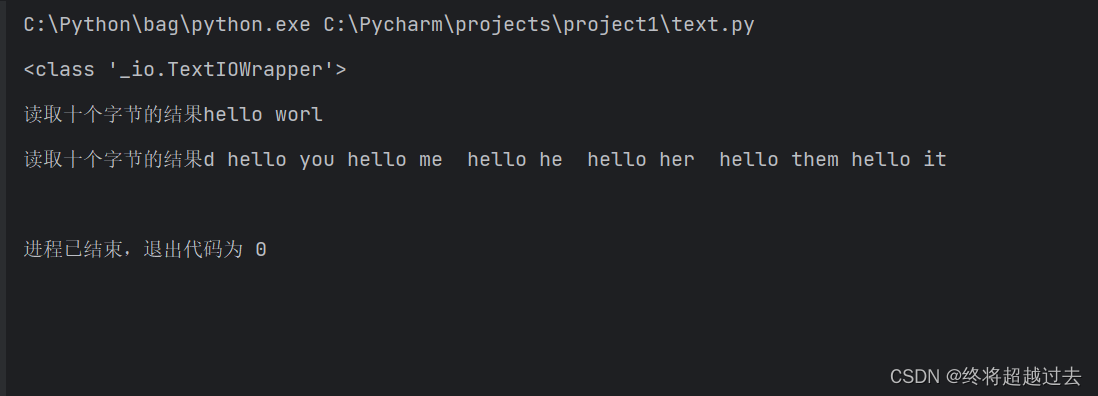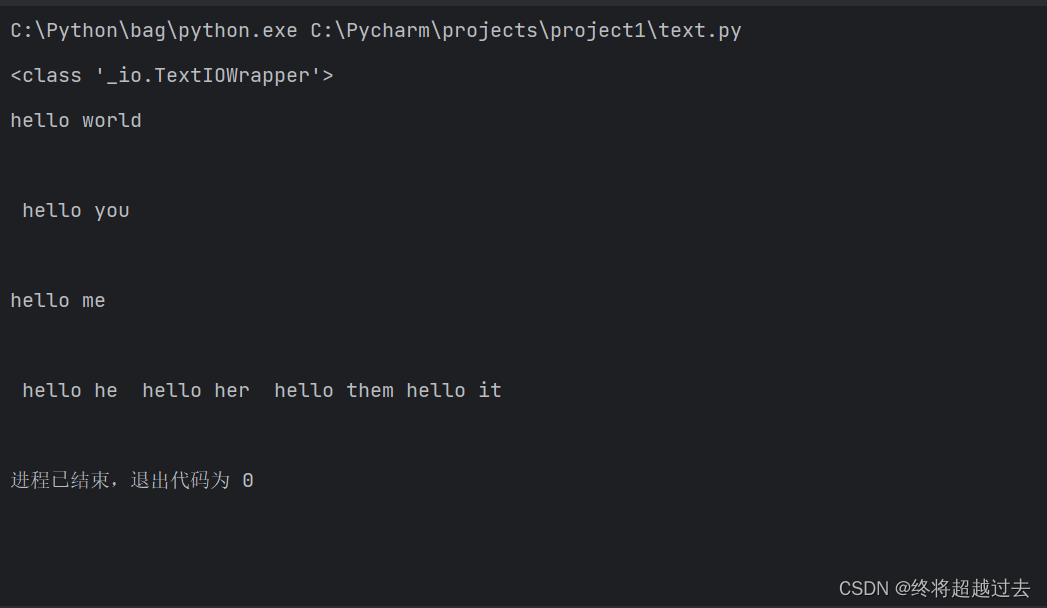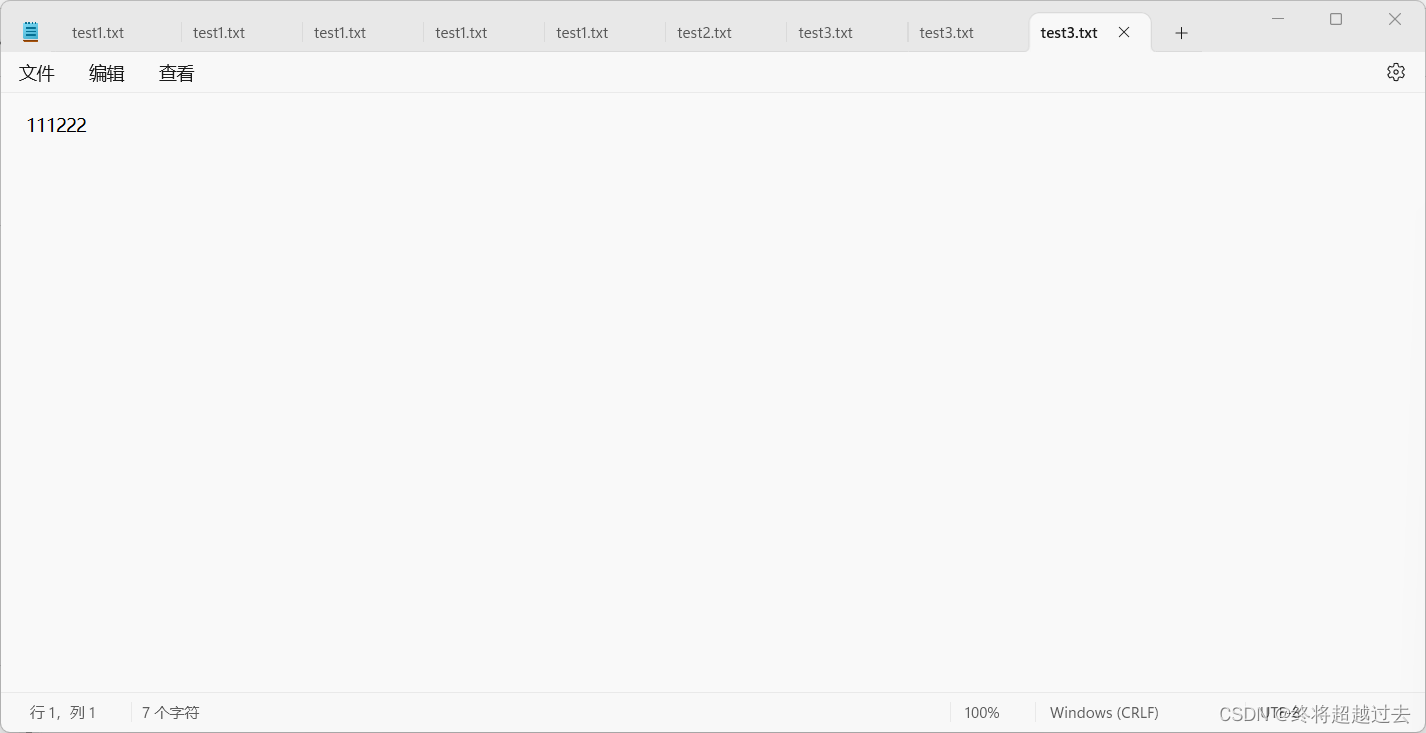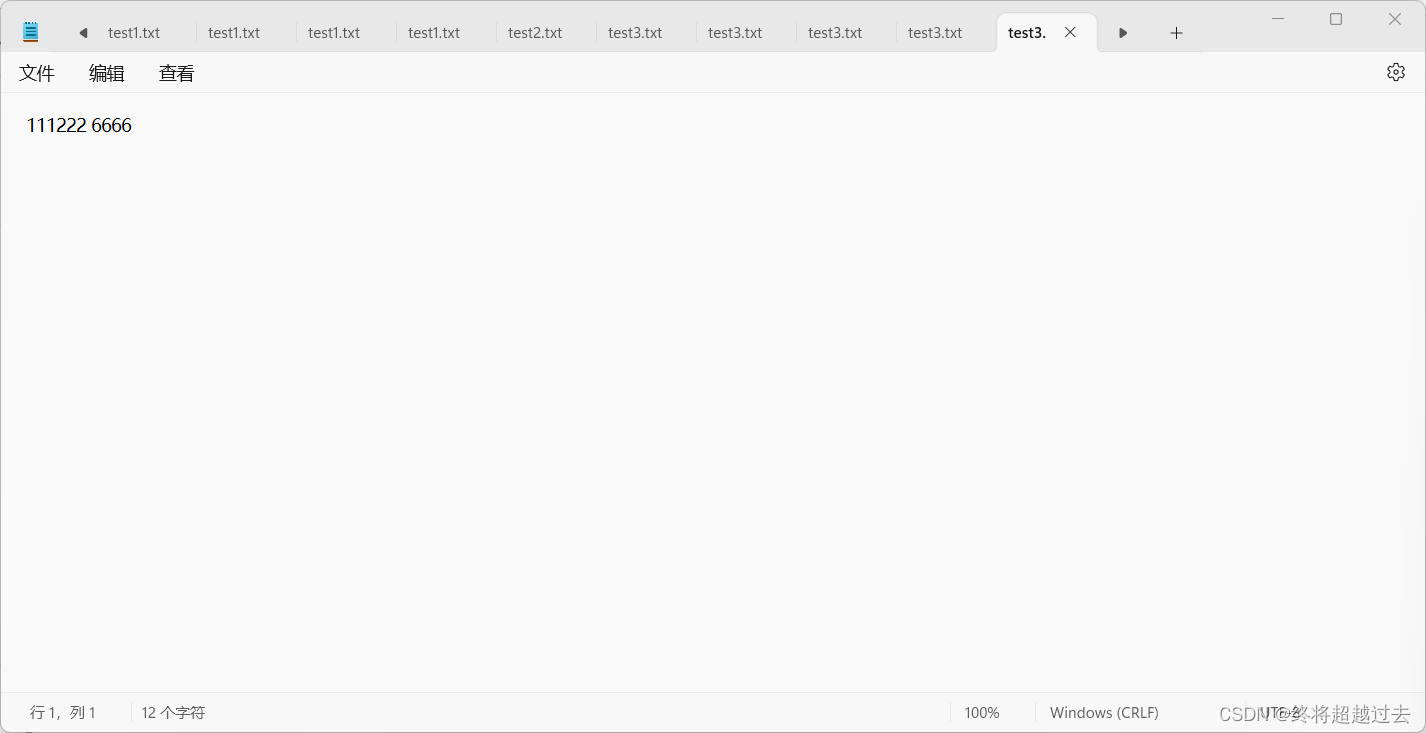热门标签
热门文章
- 1基于PPYOLOE+的水下生物目标检测_为什么要做水下显著目标检测
- 2vue2 百度地图点聚合_vue2 百度地图实现点聚合
- 3月入8.3k,新传文科生转行5G网络优化工程师,张雪峰:这专业,报考就打晕…
- 4信息安全人才这么受欢迎,为何从业者这么少?_信息安全从业者的低替代性
- 5Android Camera相机以及相机程序开发实例_android.hardware.camera 例程
- 6c#执行php,致PHP程序员:快速执行C#代码片段 快速运行C#代码 调试C# C#写人文件操作...
- 7ros源码分析(三)ros::spin( )背后发生的事_couldn't register subscriber on topic [/]
- 8数据库分页大全
- 9微信小程序登录后端
- 10小程序可以通过以下几种方式下发消息_小程序怎么给用户推送消息
当前位置: article > 正文
Python.五.文件
作者:代码架构师 | 2024-01-28 23:20:29
赞
踩
Python.五.文件
1.文件读取的操作
1.文件的打开
open(name,mode,encoding)
name:是要打开目标文件名的字符串,可以包含文件所在的具体路径
mode:设置打开文件的模式:只读 r 、写入 w 、追加 a
encoding:编码格式 UTF-8
- f=open("C:/test.txt","r",encoding="UTF-8")
- # 路径以及名字 操作 编码格式,默认都是这个
- print(type(f))

2.文件的读取
1. 文件.read(读取的字节)
- f=open("C:/test.txt","r",encoding="UTF-8")
- # 路径以及名字 操作 编码格式,默认都是这个
- print(type(f))
-
- print(f"读取十个字节的结果{f.read(10)}")

不指定参数就全部读取
- f=open("C:/test.txt","r",encoding="UTF-8")
- # 路径以及名字 操作 编码格式,默认都是这个
- print(type(f))
-
- print(f"读取十个字节的结果{f.read()}")

连用多次read,后面的read会接着上一次read的结束位置读取
- f=open("C:/test.txt","r",encoding="UTF-8")
- # 路径以及名字 操作 编码格式,默认都是这个
- print(type(f))
- print(f"读取十个字节的结果{f.read(10)}")
- print(f"读取十个字节的结果{f.read()}")

2. 文件.readlines()
读取全部行,封装到列表里面
- f=open("C:/test.txt","r",encoding="UTF-8")
- # 路径以及名字 操作 编码格式,默认都是这个
- print(type(f))
- lines=f.readlines()
- print(f"lines类型是{type(lines)}")
- print(f"lines内容是{(lines)}")

3.文件.readline()
一次读取一行
4.for循环读取文件每一行
- f=open("C:/test.txt","r",encoding="UTF-8")
- # 路径以及名字 操作 编码格式,默认都是这个
- print(type(f))
- for line in f:
- print(line)

3.文件的关闭
不关闭的话,当程序一直运行,文件就会一直被占用
1.手动关闭
文件.close()
- f=open("C:/test.txt","r",encoding="UTF-8")
- # 路径以及名字 操作 编码格式,默认都是这个
- print(type(f))
- f.close()

2.with open方法
with open("C:/test.txt","r",encoding="UTF-8") as f:
- with open("C:/test.txt","r",encoding="UTF-8") as f:
- # 路径以及名字 操作 编码格式,默认都是这个
- print(type(f))
-

当冒号后边的语句执行完,程序就会自动close文件
4.文件的写出
1.先打开文件 f=open()
2.进行写入操作 (写入到内存)
f.write("jack111222")
3.写入之后要 (刷新到硬盘)
f.flush()
4.关闭文件 (包括了3)
f.close()
1.open打开一个不存在的文件进行写出
w模式,文件不存在,会创建新文件
会自己创建一个新的文件,后进行写出
- f=open("D:/test3.txt","w",encoding="UTF-8")
- # 路径以及名字 操作 编码格式,默认都是这个
- f.write("jack111222")
- f.flush()
- f.close()

2.open打开一个存在的文件进行写出
w模式,文件存在,会把原来的覆盖掉
- f=open("D:/test3.txt","w",encoding="UTF-8")
- # 路径以及名字 操作 编码格式,默认都是这个
- f.write(" 111222")
- f.flush()
- f.close()

5.文件的追加
在文件原有内容不变的基础上追加
不改变原来的内容,文件不存在也不能创建新文件
-
- f=open("D:/test3.txt","a",encoding="UTF-8")
- # 路径以及名字 操作 编码格式,默认都是这个
- f.write(" 6666")
- f.flush()
- f.close()
-

声明:本文内容由网友自发贡献,不代表【wpsshop博客】立场,版权归原作者所有,本站不承担相应法律责任。如您发现有侵权的内容,请联系我们。转载请注明出处:https://www.wpsshop.cn/blog/article/detail/42161
推荐阅读
- 文章浏览阅读1.5w次,点赞124次,收藏198次。Pygame是一个基于Python的游戏开发库,它提供了一系列的工具和接口,使开发人员能够轻松地创建各种类型的游戏,包括2D游戏和简单的3D游戏。Python“贪吃蛇”游戏,在不断改进中学... [详细]
赞
踩
- 文章浏览阅读6.5k次,点赞46次,收藏39次。FastAPI库(Python的Web框架)基本使用指南(二)FastAPI库(Python的Web框架)基本使用指南(二)核心功能定义路由FastAPI中定义路由的方式主要有两种,一种是使用... [详细]
赞
踩
- 文章浏览阅读3k次,点赞4次,收藏16次。Python是一种高级编程语言,它具有简单、易学、高效等特点。而Pythonget()函数是其中一个重要的函数。该函数用于返回指定键的值,如果键不存在,则返回默认值None。下面将从各个方面对Pyt... [详细]
赞
踩
- 文章浏览阅读1.1w次,点赞55次,收藏66次。本文仅分享Githack工具基本安装及使用相关知识不承担任何法律责任。Git是一个非常流行的开源分布式版本控制系统,它被广泛用于协同开发和代码管理。许多网站和应用程序都使用Git作为其代码管理... [详细]
赞
踩
- 文章浏览阅读6.9k次,点赞46次,收藏122次。get()是获取网页最常用的方式,在调用requests.get()函数后,返回的网页内容会保存为一个Response对象,其中,get()函数的参数url必须采用HTTP或HTTPS方式访... [详细]
赞
踩
- 文章浏览阅读1.5k次,点赞44次,收藏46次。6.2.4修改字典中的值要修改字典中的值,可依次指定字典名、用方括号括起的键以及与该键相关联的新值。我们首先定义了一个表示外星人alien_0的字典,其中只包含这个外星人的颜色。接下来,我们将... [详细]
赞
踩
- 文章浏览阅读3.8k次。本文介绍了Django框架中文件上传和处理的基本原理和实现方法,以及阿里云oss的对接方法。Django提供了一些内置的功能和工具,使文件上传变得简单和安全。它提供了一个处理文件上传的高级API,可以验证上传的文件... [详细]
赞
踩
- 文章浏览阅读1k次,点赞80次,收藏72次。本文主要介绍了集合和字典相关的知识,其中集合最大的特点就是无序和无重复,有三个特殊的操作,取出差集,消除差集,集合合并;字典最大的特点就是每个数据都是KeyValue键值对,且Key不可重复【Py... [详细]
赞
踩
- 文章浏览阅读4.4k次,点赞41次,收藏263次。深入探索Python的Pandas库:从核心数据结构到高级特性,本指南为你提供了全面的Pandas知识概览。无论你是数据初学者还是专家,都可在此找到宝贵的insights和技巧,助力你的数据... [详细]
赞
踩
- 文章浏览阅读2k次,点赞104次,收藏87次。OpenCV(OpenSourceComputerVisionLibrary)是一个开源的计算机视觉库,提供了丰富的图像处理和计算机视觉算法。它由一组用C++编写的函数和工具组成,同时也支持多种... [详细]
赞
踩
- 文章浏览阅读1.1w次,点赞43次,收藏270次。python-爬虫(可直接使用)python-爬虫(可直接使用)爬虫(WebScraping)是指通过编程自动化地获取互联网上的信息的过程。爬虫的目的通常是从网页中抓取数据,进行数据分析、处... [详细]
赞
踩
- 文章浏览阅读1.5k次,点赞8次,收藏12次。MAE的误差大概在0.11,以下数据均是预测未知数据。Holt-Winters模型,也称为三重指数平滑模型,是一种经典的时间序列预测模型,用于处理具有趋势和季节性的时间序列数据。Holt-Win... [详细]
赞
踩
- article
Unable to create process using ‘D:\Anaconda3\python.exe D:\Anaconda3\Scripts\conda-script.py shell.c
文章浏览阅读1w次,点赞20次,收藏17次。记录一下和Anacondaprompt斗智斗勇的一天,早上打开电脑,准备用prompt打开jupyter写点东西,结果人傻啦,报错无法启动进程。。。注意是先报错,后进入起始位置可以输入cmd指令,... [详细]赞
踩
- 文章浏览阅读5.6k次,点赞2次,收藏12次。在“installcsvba”这个文件夹中新建一个名为“template”的文件夹,其中存放着所有csv文件的二进制文件,比如:接下来,我们以“installcsvba”这个工程为例,来介绍一下... [详细]
赞
踩
- 文章浏览阅读4.1k次,点赞95次,收藏100次。维诺图的应用涵盖了多个领域,包括计算机图形学、地理信息系统、计算机视觉等。本文介绍维诺图在运动规划中的概念,并结合C++/Python/Matlab三种实现加深理解,为后续基于维诺图的路径规... [详细]
赞
踩
- 文章浏览阅读5.5k次,点赞123次,收藏181次。上述代码完成了一个简单的情感分析任务。根据具体需求和数据集,您可能需要调整预处理步骤、特征提取方法和支持向量机参数。此外,还可以尝试使用其他机器学习算法,如神经网络、决策树、随机森林等,以... [详细]
赞
踩
- 文章浏览阅读6.9k次,点赞26次,收藏138次。LSTM(LongShort-TermMemory)是一种常用的循环神经网络(RNN)模型,用于处理序列数据,具有记忆长短期的能力。在时间序列预测中,LSTM既可以多元预测机制又可以作为单元... [详细]
赞
踩
- 文章浏览阅读1.1k次。SegmentAnything可以实现对任意物体的识别和分割提供了简单易用的接口,用户只需要通过提示,即可进行物体识别和分割操作,今天给大家分享一下SAM的源码。【Python&语义分割】SegmentAnythin... [详细]
赞
踩
- 文章浏览阅读4.3w次,点赞291次,收藏1.3k次。本文一步一步地教你如何用Pyinstaller模块将Python程序打包成exe文件!这篇教程绝对是全网最全面、最详细的教程!包含五种打包的方法,从简单到复杂依次是:一般打包方法、虚拟环... [详细]
赞
踩
- 文章浏览阅读2.4w次,点赞62次,收藏642次。PythonCNN卷积神经网络实例讲解,CNN实战,CNN代码实例,套用简单_pythoncnnpythoncnn一、CNN简介1.神经网络基础输入层(Inputlayer),众多神经元(N... [详细]
赞
踩
相关标签




